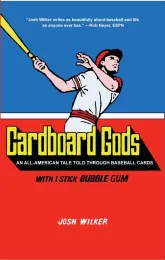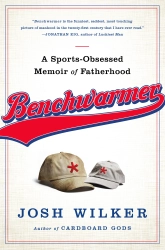 The Cardboard Gods Ass Backwards ABCs of Parenting
The Cardboard Gods Ass Backwards ABCs of Parenting
T Is for Tekulve
Writing while parenting a newborn is like working an inning here and an inning there, loping in from the bullpen without much preparation and heaving some pitches and hoping not to get shelled. I write in little bursts, and I can’t really connect one appearance to any previous appearances. I know the hook is coming, too. It’s a quick hook. This post will not be the equivalent of a complete game but a patchwork of incomplete innings. This is the lot of the reliever.
***
Parenting a newborn is itself like relief pitching. That is, it bears some similarities to a weary bullpen protecting an endless series of endangered leads. Like a chain of relievers passing the burden of a collapsing lead to one another, my wife and I hand the baby back and forth, trying to stem the momentum toward whining then full-on spittle-choke sobs. I’m the marginally useful hurler constantly tinkering with an ineffective array of junk, called into action in situations unsuitable for the staff ace, my wife, possessor of a devastating out pitch (her boobs).
***
According to an excellent biography on the SABR bio website, Kent Tekulve’s “first exposure to baseball was playing catch with his father.” I didn’t play catch with my father. He has no interest in baseball. He did tell me, when I was a boy, to try to write something every day. I’m trying, I’m trying. I’m always trying and always will.
***
Tekulve did not develop his unusual pitching style until years after playing catch with his father. It wasn’t until his pro career began that he decided to pattern a submarining style after what he could recall about the approach of Ted Abernathy, who had pitched effectively for the Reds while Tekulve was growing up in Cincinnati. Tekulve in turn handed down the unusual style to Dan Quisenberry during spring training of 1980. Quisenberry quickly became a star, eclipsing his mentor throughout most of the 1980s, though Tekulve continued to be an effective, tireless, and remarkably consistent reliever in his own right. Tekulve had turned 41 by the time the 1988 card at the top of this post came out, yet in the previous season he led the major leagues in games pitched, with 90, while managing an ERA of 3.09, a very good mark for the home-run-hitting extravaganza that was 1987. He had another useful season in 1988, then finally came to the end of his remarkable and remarkably underrated career in 1989 with a few subpar appearances for the team of his youth, the Reds. Discounting his first brief call-up in 1974 and his last brief go-round in 1989, Kent Tekulve never had a bad year. Relievers almost as a rule go up and down, their numbers the most difficult to predict from one year to the next. Kent Tekulve was that most admirable thing in a reliever. He was steady.
***
My dad went to work every day, no matter what. This was somewhat unusual in the 1960s and 1970s, an era in America when relative prosperity combined with (and probably contributed to) a powerful cultural trend toward self-exploration most commonly referred to back then as “finding oneself.” Everyone was always setting off to find him or herself back then. Not my dad, so far as I know. He either didn’t want to find himself or he already knew where he was. I think of him at a desk. A guy with glasses sitting at a desk. That’s where he still is much of the time, actually. So am I, come to think of it. I’m at a desk right now. Every day, even if for just a third of an inning, or less if I can’t even so much as record a single out or complete a single thought.
***
Kent Tekulve was a hero of mine around the time when my dad told me to try to write something every day. I was a skinny bespectacled kid on the brink of stumbling out of a warm albeit somewhat peculiar childhood into a much grayer awkward adolescence, and as the specter of the lonely era to come loomed, Tekulve, the rail-thin relief ace of the mighty late 1970s Pirates, offered some hope that I could, like Tekulve, find an unlikely place in the middle of the action. In the 1988 card at the top of this post Tekulve, sporting some wrinkles and the beginnings of a pear shape, is unquestionably a member of the adult realm, an adult like all the adults, a guy who would blend into a crowd, but in the cards that I collected in the 1970s he was much thinner and shadowy and more distant from the rest of the world around him and because of that distance closer to my own world of growing distances.
***
Kent Tekulve doesn’t get enough credit as an elite practitioner of his craft. There’s a stat now in use called adjusted ERA (ERA+) that siphons a player’s earned run average through some machinations to account for league and park factors. Basically, it’s a way of showing that, for example, Larry Dierker’s 3.31 earned run average in 1968, when pitching in the cavernous Astrodome during the “year of the pitcher,” was quite a bit less impressive than, say, Francisco Cordova’s 3.31 earned run average in the steroidal homerfest that was 1998. Kent Tekulve is tied for 31st all-time on the career ERA+ list. A few relievers are ranked ahead of him on the list, but not one of them (besides Hoyt Wilhelm, who also pitched for several seasons as a starter) has more innings pitched.
***
I guess if you are a reliever and aspire to immortality you need a gimmick. Tekulve did not really have one. He threw underhanded, more or less, and had glasses, which I guess could be considered gimmicks, but Hall of Fame voting has an element of the channeling of male childlike fantasies of comic-book power (this is, I believe, the subconscious core of the “gut” feeling some “old school” voters talk about when brusquely explaining their Hall of Fame picks), and the elements of Tekulve’s game that might come into the mind of a voter point more toward the flaccid powerlessness of a Clark Kent than to the soaring phallic omnipotence of a Superman. Think of the relievers who have gotten into the Hall of Fame thus far. They all had comic-book superhero attributes. Wilhelm had the baffling uncanny knuckler, like something that would have spiraled forth from the spell-setting fingers of Dr. Strange; Goose Gossage’s fastball and persona raged and rampaged, Hulk-style; Bruce Sutter had an awe-inspiring mad-scientist forkball; Rollie Fingers coupled his excellent but by no means inimitable achievements with a spectacular cartoon mustache and cartoon name. These guys all had good numbers, but Tekulve’s numbers are comparable, and, to use the term for reliever in use in his day, “fireman,” he entered more burning buildings than any of them.
***
I’ve always been drawn to Tekulve because I was a thin bespectacled kid, but I think it’s not necessarily the Clark Kentian eyewear that has brushed him to the side in talk of great relievers as it is his submarine pitch. The pitch, it’s . . . girly. Consider Tekulve’s protégé, the great Dan Quisenberry. I mentioned ERA+ above; the Quiz’s career ERA+ ranks fifth all-time, behind only Lefty Grove, a short-tenured 19th Century pitcher named Jim Devlin, Pedro Martinez, and Mariano Rivera. The Royals ace did not pitch for that long—not anywhere near as long as Tekulve—but neither did Bruce Sutter, who is in the Hall of Fame. The difference? Quiz threw the submarine pitch. I’m telling you, Hall of Fame voting is done with the imagination to some extent, and it’s generally a very strongly Neanderthalic male imagination that values things that crush and smash and are “feared”; it would naturally shy away from things that are somehow vaguely womanly, even if those things are effective. I mean, there was a kid in my little league who threw sidearm. I felt embarrassed for him. I felt embarrassed for anyone who couldn’t fire a good overhand pitch. My father couldn’t. I always worried that this would come to light.
***
My dad throws ideas at me. The gist of them is that, as things stand now, and until we bring about changes, we—as in we the people—don’t have our hands on the reins. We are in many ways dominated by a microscopically tiny percentage of the population. I don’t really understand how this works, and besides studying some of my father’s chosen field, sociology, in college 20 years ago I haven’t done much to learn about it and don’t do anything to fight it. I have a job at a corporation. It helps me and my family get by and provides us with some health insurance. I go to work, come home from work, do what I can to help my wife take care of our baby, write when I can, maybe go for a run. With any other spare time, I generally think about or read about or cheer for sports. Why? I ask this question periodically, and most recently I found myself asking it in regard to the current term for a team’s standout reliever: “dominant closer.” This wasn’t always the term used. I often find myself recoiling from new developments in the lingo of sports, and this is no exception. Compare the term “dominant closer” to a term applied with great accuracy to Kent Tekulve in his day: “reliable fireman.” The 1970s populism reflected most stridently in the theme song, “We Are Family,” of Tekulve’s 1979 Pittsburgh Pirates champs also comes through in “reliable fireman,” a term suggesting a sense that that we can count on one another even in tough times, that we are all in this together. Or, we were all in this together. Things appear to be different now, at least according to the current terminology used for an effective relief pitcher. The noun in this term, “closer,” conjures cutthroat Glengarry-Glen-Ross victimization, and the adjective, “dominant,” adds to it a testosterone whiff of subjugating simian brutality. It’s sort of sickening, if you think about it. I don’t want to dominate anyone. But, if I’m being honest, I sure do like it when my sports teams win. Following sports is a way, I guess, to fantasize guiltlessly about being, for once, the one with the hands on the reins, the dominant victimizer.
***
Kent Tekulve was my passageway from childhood into what came after it, and what came after it lasted all the way until this past July, when my own son was born. Now I’m no longer a loner on the outside of things. I’m the guy my son will first look to. Will I be steady? Will I be reliable? I don’t know. I do know I’ll no longer primarily be the uninspired star of my own tedious story but a supporting player in another new story. I’ll be the guy with glasses sitting at a desk.






You must be logged in to post a comment.